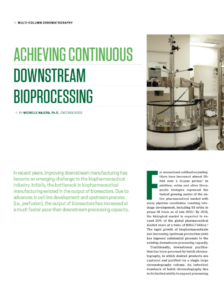 In recent years, improving downstream manufacturing has become an emerging challenge to the biopharmaceutical industry. Initially, the bottleneck in biopharmaceutical manufacturing existed in the output of bioreactors. Due to advances in cell line development and upstream process (i.e., perfusion), the output of bioreactors has increased at a much faster pace than downstream processing capacity.
In recent years, improving downstream manufacturing has become an emerging challenge to the biopharmaceutical industry. Initially, the bottleneck in biopharmaceutical manufacturing existed in the output of bioreactors. Due to advances in cell line development and upstream process (i.e., perfusion), the output of bioreactors has increased at a much faster pace than downstream processing capacity.
Therapeutic biologics, including monoclonal antibodies (mAbs), represent the fastest growing segment of the pharmaceutical market. By 2019, the biological market is expected to exceed 20% of global pharmaceutical market share. This increasing upstream production yield imposes substantial pressure on the existing downstream processing capability.
Downstream purification has traditionally been governed by batch chromatography, in which desired products are captured and purified via a single large chromatography column. An imbedded drawback of batch chromatography lies in its limited ability to expand processing capacity. Once installed, switching the existing capture column to a larger-size column is often physically and economically challenging. Another design flaw in batch chromatography is its inability to load chromatography resin to its full capacity since product breakthrough must be avoided, which can translate to an underutilization of the resin and hence considerable resource waste.
The biopharma industry would benefit greatly from an improved process to more efficiently use the resin in the capture step. Multi-column chromatography (MCC) achieves both better productivity and cost reduction, making it an attractive solution to meet this challenge. Most importantly, remarkable recent progress has been made in this area, enabling smooth implementation of MCC into downstream bioprocessing.
MCC is based on the same fundamental principles as batch chromatography with slight differences in design, operation and application. In this article, we discuss using the product and process knowledge accumulated through batch processing, to transition from batch to MCC downstream processing, and the advantages gained through this transition to continuous downstream bioprocessing.
